 |
The Saint of the Day
St. Valeriano - July 9
Prof. Plinio Corrêa de Oliveira
Biographical selection:
Ariadne, daughter of Eastern Roman Emperor Leo I (ruled 457-474), married Zeno the Isaurian, and gave him a son. The birth of this boy pleased the Emperor and, since he had no son, he considered this grandson as heir to the throne. However, the small Prince was attacked by a strange illness that had characteristics of a diabolical possession. All the remedies applied to cure the child were useless.
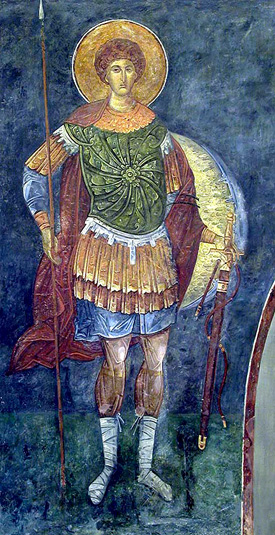
A military saint in a Byzantine painting
|
At that time a young man called Valeriano was living in Armenia. His reputation for sanctity was great, for through his prayers God worked great miracles. Leo I heard of him and sent a messenger asking him to come to Constantinople. Valeriano agreed. While visiting the child, he made a Sign of the Cross over him, and the illness left without any trace. As a reward for this action, Leo I treated Valeriano in a truly imperial way. Since he was intelligent and wise, the Emperor offered him a position as one of his first palace officials.
This sudden rise of status did not change the habits of Valeriano, who, amidst the worldly court, always gave the best example. His pleasing appearance also contributed to the general esteem he won. The Emperor had such confidence in him that he would not make any serious decisions without first asking his opinion. Valeriano took advantage of this situation to defend the Church, his homeland (Armenia), and the poor.
At the time, the Western Roman Empire was falling apart. Italy itself was the theater of barbarian invasions, and the entire country was upset by the Arian heresy. Valeriano was sent to Italy to pacify the region of Emilia Romagna.
To insure his safety and success, the Emperor chose 80 of his best soldiers to be the personal escort of Valeriano. In combat he was very courageous and his subordinates were encouraged to see his ardent zeal in fighting the Arians, the enemies of the Catholic Religion. St. Valeriano led his troops to Forli and surrounded the city, which was under the control of Leobard, an Arian tyrant.
Every night of the siege, St. Valeriano used to leave the camp to pray alone and meditate on divine things. Leobard was informed of this by his spies in the camp. He took advantage of this situation, surprised Valeriano at prayer, and killed him. The heretic thought that without their leader, the troops would become discouraged and lift the siege. Precisely the opposite happened. Eager to avenge Valeriano';s death, the soldiers quickly took the city, punished the guilty and re-established the Catholics in their proper places.
The inhabitants of Forli chose him as their Patron Saint and placed his effigy on the seal of the city. He is mounted on his horse, with this caption underneath: St. Valeriano, martyr, protector of the city of Forli.
Comments of Prof. Plinio:
This is a most beautiful selection. To be properly understood, a short historic overview of that time is necessary.
In that epoch, the most civilized part of the world was the Mediterranean basin. Two Empires had capital importance: the Eastern Roman Empire and the Western Roman Empire. Both empires surrounded the Mediterranean Sea, which the Romans proudly called mare nostrum – our sea.
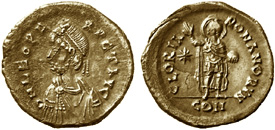
A coin with Emperor Leo I's effigy
|
The fates of these two Roman Empires were quite different. The Western Roman Empire was centered on the Italian Peninsula and encompassed all the European territory from the west of the Rhine to England and Scotland. This immense territory had suffered invasions of the barbarian German tribes, which had adopted the Arianism introduced by a heretic bishop called Ulfilas. Therefore, these barbarians invaded the Western Roman Empire with a true hatred against the Catholic Church.
To simplify things, the Arians at that time were more or less what the Protestants are today, but they had a great strength and capacity to expand, characteristics that the Protestants lost. Thus, you should imagine a powerful, active heresy at the apex of its strength entering the Western Roman Empire, riding double behind the barbarians on their horses.
This Western Roman Empire was tremendously decadent. St. Augustine pointed to the tepidity of Catholics as one the determining factors of this decadence. He also predicted that, given this general tepidity, there would be no resistance against powerful and efficacious enemies. In fact, there was no serious resistance when the barbarians invaded.
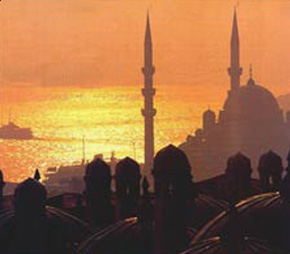
The Bosphorus seen from Constantinople
|
So, the Arian-barbarian hordes poured over all of Italy, destroying churches, killing Bishops and priests, profaning the Sacraments, and also destroying great masterpieces of Roman Civilization. This enormous earthquake, so to speak, shook the imposing Roman structure of the Western Roman Empire.
To understand the extent of those invasions, you need to realize that the barbarians did not just enter Europe to loot and then return to their places. They entered with the clear intent of staying. Thus, with these new, ignorant and heretical populations, they took over whole cities that until then had been governed by Catholics.
On the other hand, the Eastern Roman Empire shone brilliantly with all the charms of the East. Its capital, Constantinople - on the borders of the Bosphorus Strait - was considered the most beautiful city of both Empires. It was famous for its ornate churches, palaces and institutions, all set in a magnificent maritime panorama.
The emperor of the Eastern Roman Empire was titled Basileus and lived in a magnificent court, at which many saints played important roles. There were also heresies in the Eastern Empire. Actually, most of the heresies of the time were born in the Eastern Roman Empire, including Arianism.
The Catholic Religion blossomed in the Eastern Empire, principally eremitism, that is, the holy men who abandoned the cities and retired to the deserts to live completely solitary lives.
Now then, in the court of the Eastern Roman Empire lived this young Valeriano, who was, as the selection remarks, an Armenian. The Emperor invited him to assume a very important position, a kind of government minister, and he came to exert considerable influence over this entire Empire.
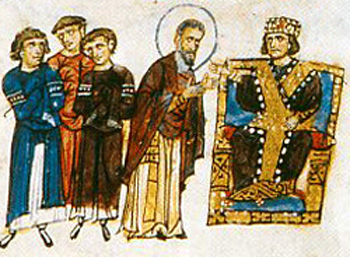
A Saint counseling the Eastern Emperor
|
We can imagine a scene from those days: in a room inside a magnificent palace, its windows opening to the Bosphorus on a typically clement day, the Emperor speaks with the Saint at a table. The Emperor is an old man, the Saint is still young. The Emperor asks counsel and the Saint, illuminated by Faith and filled with zeal for the cause of God, indicates the course to be taken. Then the Emperor rings a small bell and calls one or two of his ministers to execute his decisions. Picturing this scene, we can have some idea of the influence of St. Valeriano.
How different those times were from ours! In that epoch, a saint could influence the greatest Empire on earth. Today, there is not even the possibility that a saint would be consulted in any of the great nations of the world. To the contrary, such nations are all controlled by secret societies that promote the Revolution in order to destroy Christendom and the Catholic Church.
At a certain moment, the Emperor deemed it necessary to send St. Valeriano, a valiant man, to Italy to fight against the Arians who were oppressing the Catholics. The Emperor was so concerned to preserve Valeriano';s life, that he ordered 80 of his best soldiers to escort him as his personal guard. Valeriano, who was loved by his soldiers, attacked the city of Forli. His quarters, the general's tent, was in the center of the camp and closely guarded. However, he used to slip away every night to pray, without any guards. He needed to be away from the noise and movement of camp life to meditate on the things of God – the Holy Church, the needs of the cause of God on earth, the glory of God in Heaven, Our Lady, the Angels, Catholic doctrine, etc.
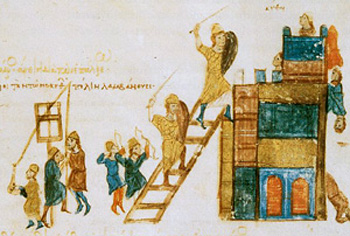
A Byzantine picture of a city being taking
|
The Arians of Forli, informed by spies of this lack of protection, sought an opportunity to kill him. One night, they fell upon him in prayer and took his life.
The Scripture says: “Strike the Shepherd that the sheep may be scattered” (Zech 4:9). The enemies expected that with the death of St. Valeriano, the army raising the siege would disperse. However, the opposite happened. St. Valeriano was prepared for Heaven and God permitted his life to be taken. Then, instead of commanding his soldiers on earth, he went to Heaven and from there ignited an unexpected fervor in his soldiers, who took the entire city. His warriors returned the Catholics to their positions of command and influence, and Our Lady returned to honor in Forli.
The inhabitants of Forli chose him as their Patron Saint. The city placed his effigy on its seal. That is to say, from Heaven he conquered the city and remained there forever. It is a perfect victory.
Even today, when the city of Forli, like every other city, is devastated by Progressivism, St. Valeriano is still there fighting spiritually to keep the city faithful to the Catholic Faith.
A wise counselor and minister of the Emperor, a thinker, a fierce warrior, a victor, a martyr, these are some attributes that sketch the profile of this manly Armenian saint we commemorate today.
Let us recommend ourselves to his protection and intercession.


  | | Prof. Plinio Corrêa de Oliveira | |
The Saint of the Day features highlights from the lives of saints based on comments made by the late Prof. Plinio Corrêa de Oliveira. Following the example of St. John Bosco who used to make similar talks for the boys of his College, each evening it was Prof. Plinio';s custom to make a short commentary on the lives of the next day';s saint in a meeting for youth in order to encourage them in the practice of virtue and love for the Catholic Church. TIA thought that its readers could profit from these valuable commentaries.
The texts of both the biographical data and the comments come from personal notes taken by Atila S. Guimarães from 1964 to 1995. Given the fact that the source is a personal notebook, it is possible that at times the biographic notes transcribed here will not rigorously follow the original text read by Prof. Plinio. The commentaries have also been adapted and translated for TIA's site.
|
Saint of the Day | Home | Books | CDs | Search | Contact Us | Donate

© 2002- Tradition in Action, Inc. All Rights Reserved
|
 |

|